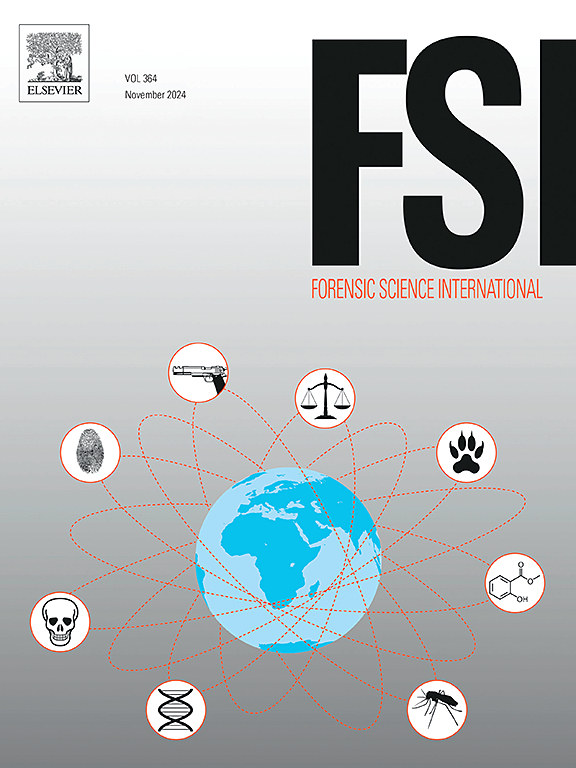Analysis of drugs of abuse and contaminants in individuals under drug surveillance programs: A study in hair samples
IF 2.2
3区 医学
Q1 MEDICINE, LEGAL
引用次数: 0
Abstract
In this study, over 900 hair samples from individuals using drugs of abuse in São Paulo and Rio Grande do Sul, Brazil were analysed for classical drugs and new psychoactive substances (NPS) in hair samples. Liquid chromatography-tandem mass spectrometry (LC-MS/MS) methods were developed for the detection of some drugs (25B-NBOMe, 25C-NBOMe, 25E-NBOH, 2C-C, 2C-I, 3,4-MDPHP, 3-MeO-PCP, 5F-MDMB-PINACA, 5-MeO-DMT, cannabidiol, ethylone, JWH 073, ketamine, mephedrone and UR-144) and drug adulterants (levamisole, phenacetin, strychnine); other substances including cocaine, amphetamines, benzodiazepines, opioids, cannabinoids were also analysed. The methods demonstrated good selectivity, linearity with lower limits of quantification ranging from 0.02 to 0.26 ng/mg, as well as precision and accuracy meeting ISO/IEC 17025 criteria. A total of 29.8 % samples were positive for at least one drug. Cocaine and its metabolites were the most frequently detected, with benzoylecgonine (111 cases), cocaine (88 cases), and cocaethylene (37 cases), highlighting prevalent cocaine use. Cannabinoids were also common, with THC (57 cases) and CBN (48 cases) detected. The presence of adulterants such as phenacetin (76 cases), levamisole (14 cases), and strychnine (3 cases) were also identified. Additionally, 5F-MDMB-PINACA was also detected (5 cases), along with ketamine (9 cases). Findings also highlighted a prevalence of poly-drug consumption, where THC was frequently detected with cocaine (20 cases) and benzoylecgonine (26 cases). CBN also showed notable associations with cocaine (16 cases) and benzoylecgonine (22 cases). These findings provide important insights into the evolving drug landscape in Brazil and highlight the effectiveness of hair analysis as a tool for monitoring drug use.
药物监测项目下个体滥用药物和污染物的分析:一项头发样本研究
在这项研究中,研究人员分析了来自巴西圣保罗和南里约热内卢格兰德州滥用药物者的900多份头发样本中的经典药物和新型精神活性物质(NPS)。建立了液相色谱-串联质谱(LC-MS/MS)检测部分药物(25B-NBOMe、25C-NBOMe、25E-NBOH、2C-C、2C-I、3,4- mdphp、3- meo - pcp、5F-MDMB-PINACA、5-MeO-DMT、大麻二酚、乙炔、JWH 073、氯胺酮、甲氧麻黄酮、乌尔-144)和药品掺假(左旋咪唑、非那西丁、士的宁)的方法;其他物质包括可卡因、安非他明、苯二氮卓类药物、阿片类药物、大麻素也被分析。方法选择性好,线性好,定量下限为0.02 ~ 0.26 ng/mg,精密度和准确度符合ISO/IEC 17025标准。共有29.8 %的样品至少有一种药物呈阳性。最常检出的是可卡因及其代谢物,其中苯甲酰冈碱(111例)、可卡因(88例)和可卡因(37例),突出了可卡因的普遍使用。大麻素也很常见,检测到THC(57例)和CBN(48例)。还发现了非那西丁(76例)、左旋咪唑(14例)和士的宁(3例)等掺假物质。此外,还检出5F-MDMB-PINACA(5例)和氯胺酮(9例)。调查结果还强调了多种药物消费的普遍性,其中四氢大麻酚经常与可卡因(20例)和苯甲酰茶碱(26例)一起被检测到。CBN还与可卡因(16例)和苯甲酰茶碱(22例)有显著相关性。这些发现为了解巴西不断发展的毒品格局提供了重要的见解,并强调了头发分析作为监测药物使用工具的有效性。
本文章由计算机程序翻译,如有差异,请以英文原文为准。
求助全文
约1分钟内获得全文
求助全文
来源期刊

Forensic science international
医学-医学:法
CiteScore
5.00
自引率
9.10%
发文量
285
审稿时长
49 days
期刊介绍:
Forensic Science International is the flagship journal in the prestigious Forensic Science International family, publishing the most innovative, cutting-edge, and influential contributions across the forensic sciences. Fields include: forensic pathology and histochemistry, chemistry, biochemistry and toxicology, biology, serology, odontology, psychiatry, anthropology, digital forensics, the physical sciences, firearms, and document examination, as well as investigations of value to public health in its broadest sense, and the important marginal area where science and medicine interact with the law.
The journal publishes:
Case Reports
Commentaries
Letters to the Editor
Original Research Papers (Regular Papers)
Rapid Communications
Review Articles
Technical Notes.
 求助内容:
求助内容: 应助结果提醒方式:
应助结果提醒方式:


